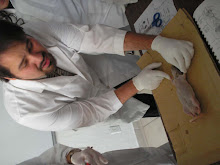On this class we saw a movie named SUPER SIZE ME.
As an introduction the movie gives numerous impressive statistics of obesity in the United States of America.
Did you now that in the United States 60% of adults have obesity? That in Mississippi 1 of every 4 people is obese? These are really impressive numbers! Don’t you think? Well it looks like many us don’t care of this but something should be done to stop this situation.
One reason is that many people don’t do any form of exercise (in the United States 60% of Americans) and this contributes the fat to stay in the body.
Another of the obvious reasons is the fast food places, for example: McDonald’s, Wendy’s, Pizza Hut, between many others. One of every four people visits a fast food place per day! But here the question is: Is this kind of food healthy at all? Of course not, this food contains a lot of calories and is cooked with a lot of oil affecting many of our organs.
Trying to prove this point of view and to make conscience in people, which is the main purpose of this movie or documentary, a man did an experiment.
The experiment consisted of eating breakfast, meal and dinner at McDonald’s for 30 days and only eating products make in there. He needed to always choose something different, choosing at least once every item in the menu. But the worst rule is that when the worker offers him supersize he needs to accept it.
The first thing he did was making some analysis and consulted three specialists in health care (doctor, nutritionist and psychologist).
Here are the levels at the beginning:
-triglycerides: 43
-glucose: 165
-cholesterol: normal
-weight: 185.5lb
-body fat: 11%
*Considering which the levels should be this is a man with a perfect health.
*He also went with a physic conditioner to make some tests and he was over the average.
Doctors told him that this idea was crazy and have many risks but he insisted on trying even knowing that his health could be severely damage. Like this he started his adventure through McDonald’s fast food restaurants.
Like three or four days after he started the seller ask him if he wanted a super size combo, and as the rules, he accepted. He was eating eat in his car and after an hour of trying to eat all that hamburger, fries and soda he vomited.
He made some surveys in the street and almost everyone whom he asked say they like fast food and didn’t know what the meaning of a calorie is. A man has a record of like 23000 Big Mac’s in his whole life, with an average of 2 or 3 per day. He went through some schools, elementary, and even if the ¨chef¨ knows they are serving bad food they don’t do anything. Well, but if the government sends them only canned food, what are they suppose to think.
After 19 days he started feeling bad. He says that he woke up feeling he couldn’t breathe and scared went to the doctor to make other analysis. The doctor told him he could destroy his liver so his girlfriend and mom told him to stop with this insane idea but surprisingly he didn’t give up and complete the 30 days.
At the end, he had gained 24.5 lb, 7% more of body fat, an increment in triglycerides, glucose levels and cholesterol and a lot of consequences: gas, chest pressure, headaches, liver illness (fatty liver), breathing difficulties, mood change, depression, addiction, fatigue, of many more.
It is important to point out that there is not only addiction to drugs, alcohol and tobacco but food can also be and addiction and in the movie they prove it. When he wasn’t eating hamburgers, fries or whatever McDonald’s product he felt sad and depressed.
So, it is important to think in the consequences of our actions not only the ones that affect other people but also actions that affect us, so choose a balance diet because life is precious and we should take care of it.





